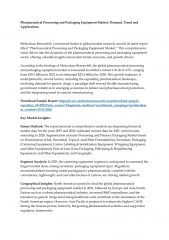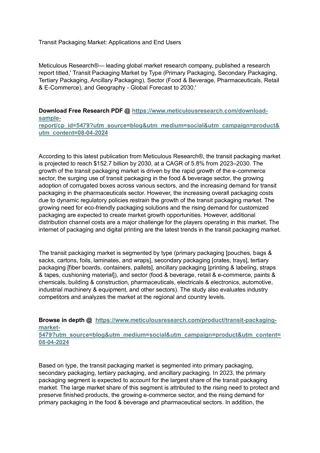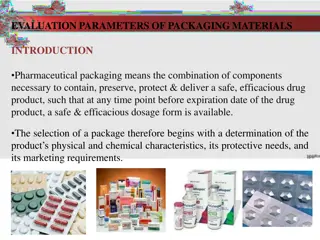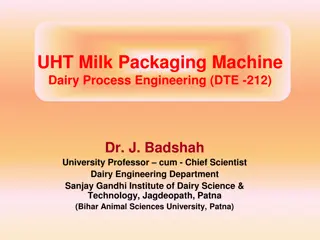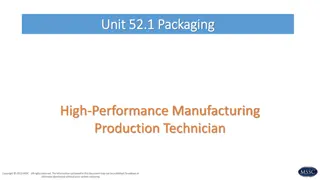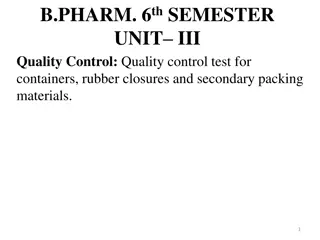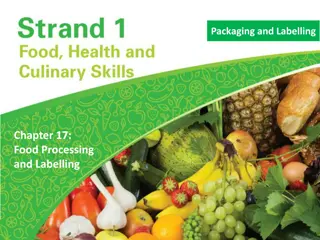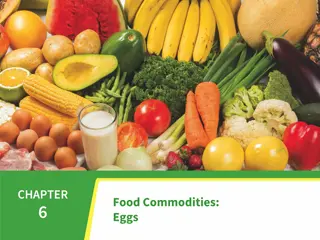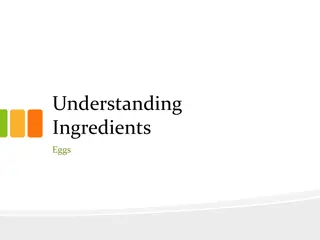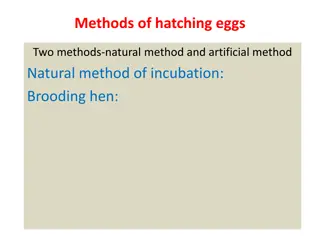Packaging of Eggs: Types, Factors, and Methods
Egg packaging is crucial to prevent shell damage and ensure product quality during storage and transportation. Factors affecting packaging include quality maintenance, storage facilities, transport type, distance traveled, climatic conditions, and costs. Various methods, such as using filler trays and specialized cases made of wood pulp or cardboard, help protect eggs and facilitate convenient counting. Plastic fillers offer reusability and transparency for easy inspection. Retail packaging options for smaller egg quantities also exist.
Download Presentation

Please find below an Image/Link to download the presentation.
The content on the website is provided AS IS for your information and personal use only. It may not be sold, licensed, or shared on other websites without obtaining consent from the author.If you encounter any issues during the download, it is possible that the publisher has removed the file from their server.
You are allowed to download the files provided on this website for personal or commercial use, subject to the condition that they are used lawfully. All files are the property of their respective owners.
The content on the website is provided AS IS for your information and personal use only. It may not be sold, licensed, or shared on other websites without obtaining consent from the author.
E N D
Presentation Transcript
PACKAGING OF EGG By- Dr. SUSHMA KUMARI Asst. Prof., Dept. of LPT,BVC BIHAR ANIMAL SCIENCES UNIVERSITY
PACKAGING OF SHELL EGGS Egg is an extremely fragile product and serious losses can result from shell damage. Economical marketing generally requires that eggs be protected by the adoption of specialized packaging and handling procedures. Packaging protects the eggs from: micro-organisms, such as bacteria; natural predators; loss of moisture; tainting; temperatures that cause deterioration; and possible crushing while being handled, stored or transported.
FACTORS AFFECTING TYPES OF PACKAGING The following factors must be taken into consideration for packaging eggs. quality maintenance; storage facilities; type of transport; distance to be travelled; climatic conditions; time involved; and costs.
TYPES OF PACKAGING Packing eggs with clean and odourless rice husks, wheat chaff or chopped straw in a firm walled basket or crate greatly decreases the risk of shell damage. It is also be possible to pack eggs in a simple basket. The basket has no cushioning material such as straw and therefore damage to the eggs may occur more easily. This kind of packaging may be fit for short distance transport.
FILLER TRAY A very common form of packaging is the filler tray. The fillers are then placed in boxes or cases. Filler trays are made of wood pulp moulded to accommodate the eggs. They are constructed so that they can be stacked one on top of the other and can also be placed in boxes ready for transport. Filler trays also offer a convenient method for counting the eggs in each box, without having to count every single egg. Usually the standard egg tray carries 36 eggs. Therefore, if a box holds five trays, for example, the box has a total of 180 eggs (36 x 5 = 180).
The cases used may be made of sawn wood; however, they are more commonly made of cardboard. When using cardboard cases, special care must be taken in stacking so that excessive weight is not placed on a case at the bottom of a stack. Fillers can also be made of plastic. The advantages of using plastic egg fillers are that they can be reused and are washable. The fillers can be covered with plastic coverings and be used as packages for final sale to the buyer. More importantly, however, plastic transparent fillers allow for the inspection of eggs without handling or touching the eggs.
Eggs can also be packed in packages that are smaller and specific for retail sale. Each package can hold from two to twelve eggs. These cases can be made of paperboard or moulded wood pulp or can be made of plastic. Egg cases have also been developed from polystyrene. The advantages of using polystyrene are superior cushioning and protection against odours and moisture.The package is also resistant to fungus and mould growth. The use of small cases is restricted by availability and cost considerations. However, small cases are good for retailers and customers. They are easy for the retailers to handle and customers are able to inspect the eggs.
LABELLING Labels are a source of important information for the wholesaler, retailer and consumer and not just pieces of paper stuck onto cartons or boxes. The important facts on the label contain information for buyers concerning the eggs, their size and weight and quality/grade description - AA, A or B. Labels may also indicate the producer, when the eggs were laid, how to store them and their expiration date.
COSTS OF PACKAGING When calculating the costs of packaging, expenses must be considered for: packaging materials; labelling; labour; additional working capital required; changing existing facilities (if applicable); and packaging machinery (if applicable).



